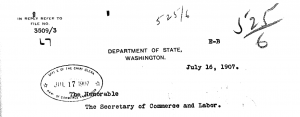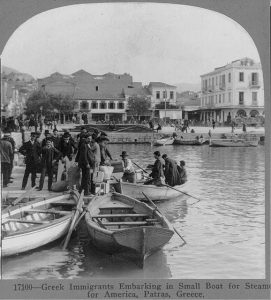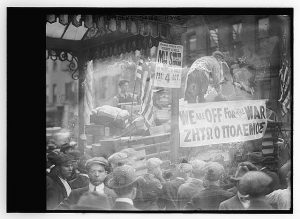
Image of the letter exchanged between the American Consul in Athens and his superiors in Washington
This document was submitted by the American Consul to the Bureau of Immigration and Naturalization in 1907 in order to inform the relevant personnel in the US government that legislation by the Greek government was being worked on to restrict and regulate emigration. The consul Herbert Knox Smith discussed the unstable political situation which was making the passing of needed emigration laws impossible. It continues by stating there are proposals in the Greek parliament to restrict emigration only to Piraeus port and to forbid the emigration of minors and of any male persons between the age of 18-21 for reasons of military service. The source also discusses how greek to not emigrate like others instead only leaving the country for a short period of time and then returning. It also mentions how in the year 1906 over 6million Francs were sent home by Greeks in the United States. (Immigration and Naturalization, 1907)
This document was created by Inspector John D. Trenor in 1908 for the American Immigration and Naturalization Service and was compiled in order to inform the American government of some of the illegal practices that were involved with the emigration of Greeks to the United States and also discuss the peonage system which was used by most of the young Greek men coming over at that time. The peonage system made it so that mostly young Greek men came over to the United States as indentured servants and were paid uncompetitive wages that made them live very frugal lives as they also had to save money to send home to bring over the rest of their family. Trenor also discusses how when Greek immigrants boarded steamers for the United States they were examined only by the ships doctor which allowed for many immigrants who were medically unfit to arrive in the US ports, usually Ellis Island. (Trenor, 1908)

The image above was taken from the Greek town of Patras in 1910 and shows a group of Greek emigrants getting ready to board a steamship and come to the United States. The image was circulated in a newspaper in order to inform Americans about Greek immigration. As can be seen in the image the majority of people emigration were young men and that they did not have many possessions with them. Embarking from smaller cities like Patra is what the Greek government attempted to put a stop to sue to the fact it was far harder to regulate.
This source was compiled by the U.S. Department of Labor from 1911 to 1914 and discusses the stories of Greeks Immigrants arriving at Ellis island and their immediate following destination. It was created with the purpose of publication for enjoyment by the general masses but also tells some of the darker truths of immigration through particular anecdotes. One story was of a young greek boy who wrote to his uncle in America to pretend to be his father to pick him up from Ellis island. Another discusses how a Greek man shot and killed his brother and came to the US under a fake name but was quickly arrested and had to go through all sorts of court cases until he was finally deported. Highlighting how poorly Greeks were treated many Greek miners were forced to leave Nevada as the other workers would not work with Greeks. One Greek-American interpreter said how it pained him to have his shoes shined by a man named Demosthenes or Socrates due to the fact that his place was at their feet at University not them at his feet in the streets. Finally, there was a stoey highlighting how Greeks moved back and forth between Greece and the United States as a troupe of Greek musicians was arrested for white slavery after they would go back to Greece and acquire young female dancers. (Immigration and Nationalization Service, 1-106)

This image published by the Bain News Service in 1912 and was supposed to inform the American populace of The Balkan War that was currently going on. The Balkan War was an alliance of Greeks, Bulgarians and Serbians against the Ottoman Empire. In the banner seen in the image it says how the Greeks are off to war and in Greek Zito means “long live” and polemos means “war.” Many Greeks were called back to fight by the King and others returned due to the heightening nationalism during the Balkan Wars. The hundreds of Greeks who returned to fight during this period also illustrated how despite migration the Greek people remained very connected to events going on in the homeland and were willing to sacrifice everything to defend it.
